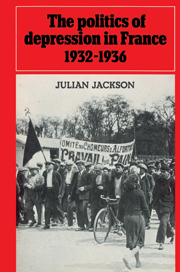Summary
The history of the four years from 1932 to 1936 falls into two periods. The 21 months from May 1932 to February 1934 were characterized by the dominance of a financial problem posing as a political problem: how to find a majority to cut government expenditure and prevent financial collapse, without, however, dislocating the majority which had won the elections. Between 1934 and 1936, the political problem having been solved by the very dislocation of that majority, the economic problem was now predominant: government expenditure must be cut in order to stimulate general deflation and avoid devaluation.
There is of course a danger of anachronism in discussing economic policy: not only that of judging policy in the light of theories developed since, but, more generally, that of expecting government intervention in the economy at all. It is only comparatively recently that such a notion has come to be considered normal: the evolution of the economic crisis, said the Radical deputy P. Jacquier, ‘only depends indirectly on our actions’. But we have seen enough demands for a more active government policy (and not only from among the Socialists) for it to be valid to wonder why so little was attempted or achieved. First it is necessary to be clear what governments between 1932 and 1934 – with perhaps the exception of the interlude of Paul-Boncour and Chéron – were not doing. They had not adopted the conservative response to the crisis which saw it as a pretext for the reversal of a trend which had been deplored but hardly resisted: ‘it has become indispensable to modify … the social system of the providential state … it is étatisme which must be hit’.
- Type
- Chapter
- Information
- The Politics of Depression in France 1932–1936 , pp. 212 - 223Publisher: Cambridge University PressPrint publication year: 1985

